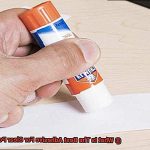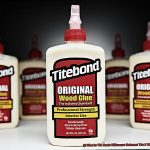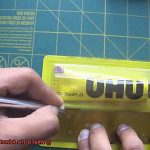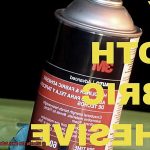Get ready to witness the magic of a small but mighty adhesive – tacky glue. This sticky wonder is adored by artists, DIYers, and creative souls worldwide for its ability to turn ordinary projects into jaw-dropping masterpieces. But what exactly is tacky glue, and how can it elevate your creative escapades?
In this blog post, we’ll embark on an exciting journey through the universe of tacky glue and its unmatched versatility. From bonding delicate paper to effortlessly securing tricky fabrics, this adhesive stands out with its exceptional stickiness and remarkable adaptability. Whether you’re a seasoned crafter or a newbie eager to dive into artistic expression, this post will provide insights, tips, and maybe even spark inspiration for your next crafting adventure.
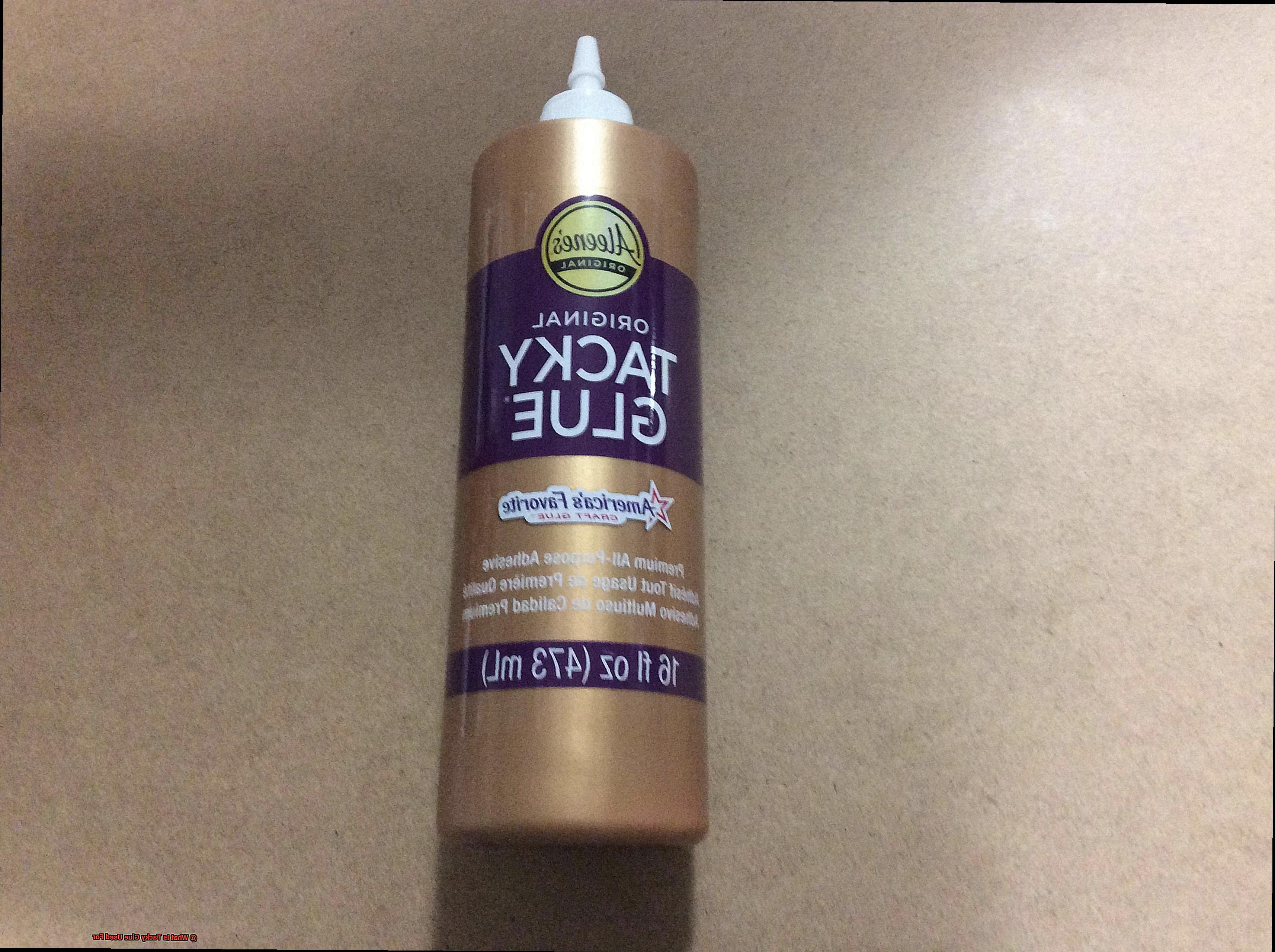
So buckle up, crafters. Prepare to discover the enchanting possibilities of tacky glue as we explore its limitless potential and uncover why it has become an essential companion for all your creative endeavors. Let’s dive into this glue-drenched adventure together.
What is Tacky Glue?
Contents
- 1 What is Tacky Glue?
- 2 Uses of Tacky Glue in Paper Crafting
- 3 Uses of Tacky Glue in Fabric Crafts
- 4 Uses of Tacky Glue in Jewelry Making
- 5 General Household Repairs with Tacky Glue
- 6 Advantages of Using Tacky Glue
- 7 Tips for Working with Tacky Glue
- 7.1 Apply Sparingly:
- 7.2 When applying tacky glue, it’s helpful to use a small brush or toothpick to spread the glue evenly and precisely. This allows for greater control over the amount of glue being applied, especially on smaller surfaces or intricate details. By using these tools, you can avoid excess glue from seeping out and creating a messy appearance.
- 7.3 Patience is Key:
- 7.4 Tools of the Trade:
- 7.5 Clean-Up Made Easy:
- 8 Alternatives to Tacky Glue
- 9 Conclusion
When it comes to unleashing your creativity, having the right adhesive is crucial. Among crafters and DIY enthusiasts, one adhesive stands out: tacky glue. In this blog post, we will delve into the world of tacky glue, exploring its unique properties, diverse uses, and numerous benefits.
What is Tacky Glue?
Tacky glue, also known as craft glue or white glue, is a water-based adhesive with a remarkable sticky and tacky consistency. It earned its name from its ability to cling powerfully to materials without slipping or sliding. This versatile adhesive dries clear, making it perfect for a wide range of applications.
Uses of Tacky Glue:
- Paper Crafting: Tacky glue is a godsend for scrapbooking, creating greeting cards, and other paper crafts. With its potent bond and quick drying time, it ensures your paper projects stay intact without any unsightly marks.
- Fabric Crafts: From attaching patches to garments to crafting plush toys, tacky glue securely bonds fabric pieces together. Its transparent drying property ensures no visible traces are left behind.
- Jewelry Making: Tacky glue is an invaluable tool for jewelry making. It effortlessly holds beads, gemstones, and other embellishments onto various surfaces like metal, glass, or plastic. Its strong bond guarantees your jewelry pieces stay firmly in place.
Benefits of Tacky Glue:
- Rapid Drying Time: Unlike many adhesives that take hours or days to dry completely, tacky glue typically dries within minutes. This allows you to complete your projects efficiently without worrying about smudging or smearing.
- Formidable Bond: Once tacky glue has dried, it forms a durable and long-lasting bond that securely holds materials together. It is suitable for both temporary and permanent applications.
- Non-Toxic and Easy to Clean: Tacky glue is non-toxic and safe to use, making it ideal for children’s crafts. Additionally, it is easily washable with soap and water, ensuring effortless clean-up if any spills or excess glue occur during the crafting process.
Uses of Tacky Glue in Paper Crafting
Look no further than tacky glue. This versatile adhesive is a must-have for any avid paper crafter. With its strong bond and quick-drying capabilities, tacky glue is the secret weapon you need to create stunning projects.
One popular use of tacky glue in paper crafting is for creating collages. Whether you’re working on a mixed media piece or simply want to add some texture to your project, tacky glue can securely hold different types of paper together. Layer and overlap various papers to create a visually interesting collage that will wow your friends and family.
Scrapbooking enthusiasts also swear by tacky glue. Its ability to adhere photos, embellishments, and other decorative elements to scrapbook pages is unmatched. With tacky glue, confidently attach precious memories to your scrapbooks without worrying about them falling off over time.
If you’re into making handmade cards, tacky glue is your best friend. Attach cardstock, patterned paper, and other elements using tacky glue to create unique and personalized cards. Whether it’s a birthday card, a thank-you card, or a holiday greeting, tacky glue ensures that your creations stay intact.
But that’s not all. Tacky glue is perfect for making paper flowers too. Use the adhesive to attach petals and leaves together, resulting in beautifully crafted flowers that can be used as decorations or embellishments on various projects. The possibilities are endless.
What sets tacky glue apart from other adhesives like regular white glue or tape is its ability to dry clear without leaving any visible residue on the paper surface. No unsightly marks ruining your masterpiece.
Remember, a little goes a long way with tacky glue. Apply it sparingly to avoid excess seeping through the paper or causing wrinkling. Give it adequate drying time for a strong bond between the papers.
Uses of Tacky Glue in Fabric Crafts
With its strong and reliable bond, tacky glue is an essential tool in any fabric crafter’s arsenal. Let’s explore the various uses of tacky glue in fabric crafts and discover why it’s a must-have supply for all your creative endeavors.
One of the primary uses of tacky glue in fabric crafts is for appliqué work. Whether you’re adding a whimsical design to a quilt or embellishing a garment with decorative patches, tacky glue ensures that your appliqué stays securely attached. Its strong bonding properties withstand multiple washes and regular use, ensuring that your fabric creations last.
But tacky glue doesn’t stop there. It’s also perfect for attaching trims and embellishments onto fabric. Whether you’re adorning your project with lace, sequins, beads, or ribbons, tacky glue provides a reliable and durable bond that keeps these decorative elements firmly in place. No more worrying about loose trims or falling embellishments.
Fabric collages are another popular craft where tacky glue shines. Layering different fabrics together to create visually appealing compositions is made easy with this adhesive. Simply apply tacky glue between the layers of fabric to hold them together, allowing for easy manipulation and arrangement before permanent stitching. The possibilities are endless when it comes to fabric collage designs.
Speaking of repairs, tacky glue is a lifesaver when it comes to fixing torn seams or reattaching loose buttons. Its strong bonding properties make it an effective adhesive for these quick fixes, providing a temporary or permanent solution depending on your needs. Say goodbye to wardrobe malfunctions and hello to seamless repairs.
Tacky glue can even be used for fabric painting projects. By mixing it with acrylic paint, you can create a textile medium that adheres to fabric without bleeding or fading over time. Tacky glue also helps prevent cracking or peeling off after drying, ensuring your painted designs stay vibrant for years to come. Let your creativity flow and create unique painted fabric masterpieces.
When using tacky glue in fabric crafts, it’s important to let the glue dry completely before handling or washing the item. This ensures that the bond is fully set and the adhesive has reached its maximum strength. Patience is key when working with tacky glue.
Uses of Tacky Glue in Jewelry Making

Look no further than tacky glue. This versatile adhesive is a must-have tool in any jewelry maker’s arsenal, thanks to its strong bond and easy application. Let’s explore the various uses of tacky glue in jewelry making and discover how it can take your creations to the next level.
First and foremost, tacky glue is perfect for securely attaching beads and gemstones to various surfaces. Its thick consistency allows for precise placement, ensuring that your precious stones stay put without shifting or falling off. Say goodbye to loose beads and hello to beautifully crafted jewelry that stands the test of time.
But it doesn’t stop there. Tacky glue also comes in handy when it comes to securing findings like clasps, jump rings, and earring backs. These essential components need a strong bond to ensure they stay securely in place, giving you peace of mind as you wear your creations. No more worrying about lost earrings or broken clasps – tacky glue has got you covered.
Looking to add a touch of glamour to your designs? Tacky glue is here to help. Attach rhinestones and sequins with ease, as this adhesive dries clear, allowing the sparkle of these embellishments to shine through without any visible adhesive marks. Your jewelry will dazzle and impress with every wear.
But wait, there’s more. Tacky glue can also be used for making resin jewelry. Attach small objects or charms to the surface of resin and let your creativity flow as you experiment with different combinations and arrangements. The possibilities are endless when you have the power of tacky glue at your fingertips.
In addition to its adhesive properties, tacky glue also acts as a sealant in jewelry making. Coat paper or fabric elements with tacky glue to protect them from moisture and wear, ensuring that your creations stand the test of time. No need to worry about damaged or faded pieces – tacky glue has you covered.
For those who work with delicate materials like thread or wire, tacky glue is a true lifesaver. It provides a secure hold without damaging or warping these fragile components, allowing you to create intricate designs with ease. Let your imagination run wild as you bring your vision to life, knowing that your materials will stay in place.
But what if you need to make adjustments or reposition your design? Tacky glue has got you covered there too. It acts as a temporary adhesive, allowing you to make changes before it fully dries. Say goodbye to sticky situations and hello to design flexibility. With tacky glue, you can create and recreate until your heart’s content.
General Household Repairs with Tacky Glue
Today, we are about to embark on an exciting journey into the realm of tacky glue and its incredible power to conquer general household repairs. Brace yourself, because with this magical adhesive by your side, broken toys, cracked ceramics, and damaged picture frames will be a thing of the past.
Let’s begin by marveling at the versatility of tacky glue. This adhesive is a true jack-of-all-trades when it comes to materials. Wood, plastic, fabric, ceramics – you name it, tacky glue can handle it all. So, gone are the days of worrying about your favorite decorative item taking a tumble or your little one’s treasured toy suffering a tragic break. Tacky glue has got your back.
Now, let’s dive into the nitty-gritty of using tacky glue for household repairs. Gather your broken pieces and ensure they are as clean as a whistle – no dust or debris allowed. Apply a thin layer of tacky glue on both surfaces and press them together firmly. Hold on tight for a few minutes to give the adhesive time to work its magic.
But here’s the catch – tacky glue isn’t an instant fixer-upper; it requires a little patience. Give it 24 to 48 hours to dry completely, depending on the materials involved and the amount of glue used. Trust me, good things come to those who wait.
And voila. Once the glue is dry, prepare to be amazed. Your repairs will be as good as new, ready to take on the world once more. That picture frame will hang proudly on your wall again, and that beloved toy will bring endless joy to your little one.
So, next time you encounter a broken something-or-other in your home, reach for that trusty bottle of tacky glue. It’s like having a superhero in a tube – always ready to save the day and keep your household intact.
Advantages of Using Tacky Glue
When it comes to adhesive options, tacky glue stands out for its unique properties and advantages. Whether you are a crafting enthusiast, a DIY lover, or someone who frequently needs to repair various items around the house, tacky glue can be a game-changer. Let’s explore the advantages of using this magical adhesive.
- Strong Bonding Power: Tacky glue boasts a high level of adhesion, ensuring a strong and long-lasting bond between different materials. From paper to fabric, wood to plastic, tacky glue securely bonds them all. No need to worry about your crafts falling apart or repairs coming undone.
- Versatility: Tacky glue is a versatile adhesive that can be used on a wide range of materials. This eliminates the need for multiple types of adhesives and makes it convenient for various applications. Whether you are working on crafts, decorations, or repairs, tacky glue has got you covered.
- Ease of Use: Applying tacky glue is a breeze. Unlike some other adhesives that require complex application techniques or tools, tacky glue can be applied directly from the bottle. Its thick consistency allows for controlled application, minimizing mess and waste.
- Quick Drying Time: Time is precious, especially when you are working on time-sensitive projects or have multiple items to glue together. Tacky glue dries relatively fast once applied, reducing waiting time and allowing you to move onto the next step quickly.
- Flexibility: Once dried, tacky glue remains flexible and pliable. This is particularly useful when gluing materials that may experience slight shifts or movements over time. Your crafts or repairs will stay intact even if they are subjected to some degree of movement or stress.
- Non-Toxic: Safety is always a top concern, especially when working with adhesives that may come into contact with your skin or be used by children. Tacky glue is known for its non-toxic nature, making it safe for both adults and children to use. You can enjoy your crafting or repair projects without worry.
- Variety of Formulas and Finishes: Tacky glue often comes in a variety of formulas and finishes, such as clear or colored options. This allows for customization and adds an aesthetic touch to projects where the adhesive may be visible.
Tips for Working with Tacky Glue
Tacky glue is a magical adhesive that can bring your crafting dreams to life. Its unique properties make it a popular choice for various projects, from paper crafts to jewelry making. In this comprehensive guide, we will explore some essential tips and techniques for working with tacky glue. So grab your glue bottle and let’s dive in.
Apply Sparingly:
Tacky glue is thick and sticky, so it’s important to apply it sparingly. A thin layer of glue is all you need for a clean and secure bond. Too much glue can result in messy applications and uneven drying. Remember, less is more when it comes to tacky glue.
When applying tacky glue, it’s helpful to use a small brush or toothpick to spread the glue evenly and precisely. This allows for greater control over the amount of glue being applied, especially on smaller surfaces or intricate details. By using these tools, you can avoid excess glue from seeping out and creating a messy appearance.
Patience is Key:
Unlike other glues, tacky glue needs a bit more time to fully dry and set. It’s important to let the glue dry completely before handling or moving the glued items. Rushing this process can weaken the bond or even cause accidental detachment. So sit back, relax, and give your project the time it needs to dry.
To ensure proper drying, it’s best to lay your project flat and undisturbed while the tacky glue sets. This prevents any shifting or sliding of the glued items, which can compromise the bond. Consider using clips or weights to hold down any loose edges or corners until the glue has fully dried.
Tools of the Trade:
Having the right tools can make working with tacky glue a breeze. Consider using a small brush or toothpick to spread the glue evenly and precisely on smaller surfaces or intricate details. These tools allow for greater control and help prevent excess glue from seeping out.
In addition to brushes and toothpicks, having rubbing alcohol nearby can be useful for cleaning up any excess glue or removing any accidental spills. Simply dampen a cloth or sponge with rubbing alcohol and gently rub away the glue before it dries. This will ensure a clean and professional finish to your project.
Clean-Up Made Easy:
Accidents happen, but don’t worry. Tacky glue is water-soluble when wet, which means you can easily clean up any spills or excess glue with water. However, once tacky glue dries, it becomes more difficult to remove. So be sure to clean up any mishaps promptly to avoid any sticky situations.
Alternatives to Tacky Glue
Are you tired of the same old tacky glue holding your projects together? Well, fear not. I’ve delved into the world of adhesives and discovered a treasure trove of alternatives that will add a touch of pizzazz to your creations. So, let’s dive in and explore these exciting options.
First up, we have white school glue or craft glue. This trusty adhesive is probably already sitting in your craft drawer, ready to be unleashed. Similar to tacky glue, it dries quickly, but it may not be as strong. Perfect for lightweight projects and paper-based crafts, this glue is a staple for any DIY enthusiast.
If you’re looking for an adhesive with a stronger grip, consider super glue or cyanoacrylate adhesive. This stuff bonds like crazy and is perfect for materials like metal, plastic, and ceramics. But beware. Once it sets, there’s no turning back. No room for second thoughts here.
For those seeking a more permanent bond, epoxy resin is the answer. Used in woodworking and jewelry making, this adhesive provides strength and durability. Just remember that epoxy resin takes longer to cure than tacky glue, so a little patience goes a long way.
If fabrics are your medium of choice, fabric glue is your new best friend. Specially designed for bonding fabrics together, it remains flexible even after drying. Whether you’re working on sewing projects or repairing garments, fabric glue ensures a secure hold without sacrificing stretch or movement.
Now let’s talk about hot glue guns – every crafter’s secret weapon. These magical tools can bond almost anything – wood, plastic, fabric, foam – you name it. Just be mindful of the high temperature involved and watch those fingers. With hot glue, your creations will stay put with ease.
Lastly, we have double-sided tape – a crafters’ dream come true. This nifty invention is perfect for scrapbooking, card making, and other paper crafts. It provides an instant, clean bond without any drying time. Simply stick it on and voila.
PsiNogVLsGo” >
Conclusion
This adhesive marvel is a crafting essential, perfect for all your creative endeavors. Its unique formulation makes it ideal for sticking together various materials such as paper, fabric, wood, and even plastic.
Tacky glue holds strong and dries clear, ensuring your projects stay intact and aesthetically pleasing. Whether you’re scrapbooking, making jewelry, or constructing intricate models, tacky glue is your trusty companion.
With its quick-drying properties and non-toxic nature, tacky glue is safe and convenient to use.


